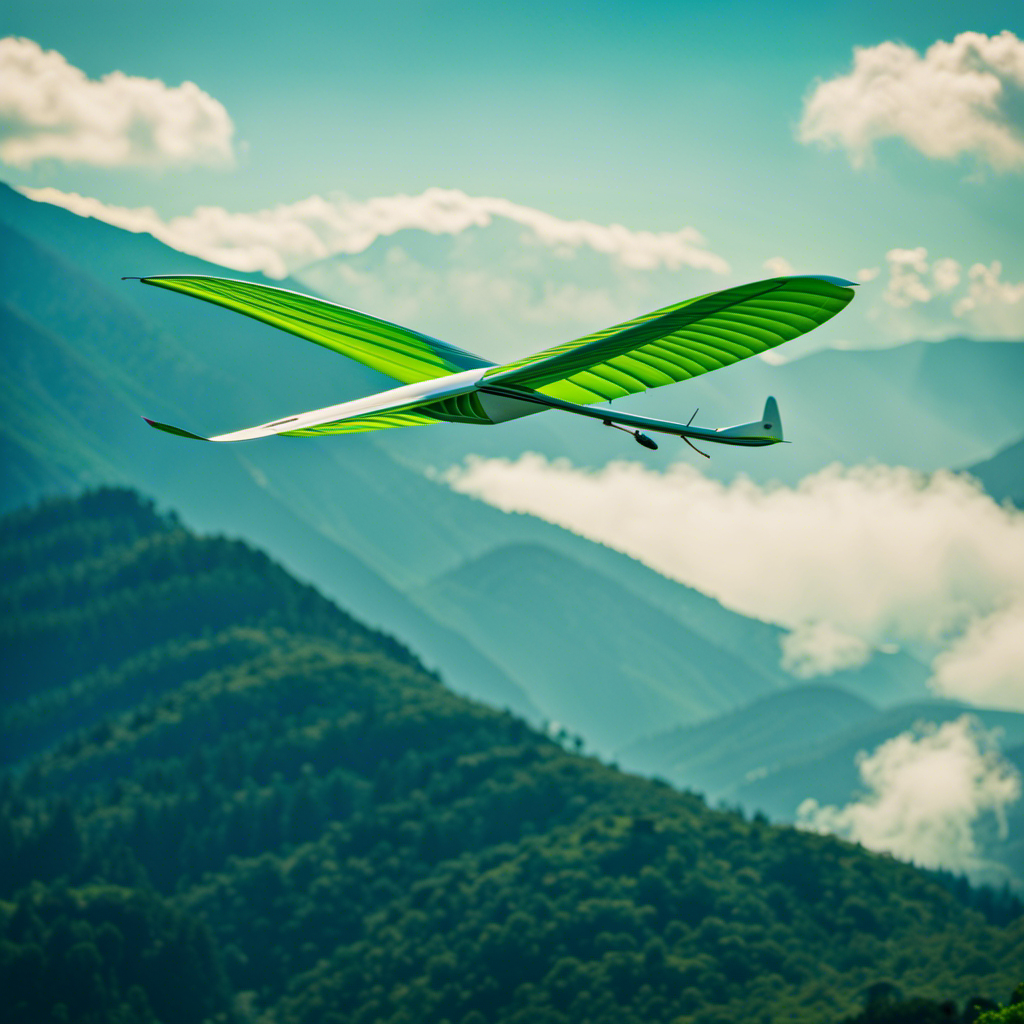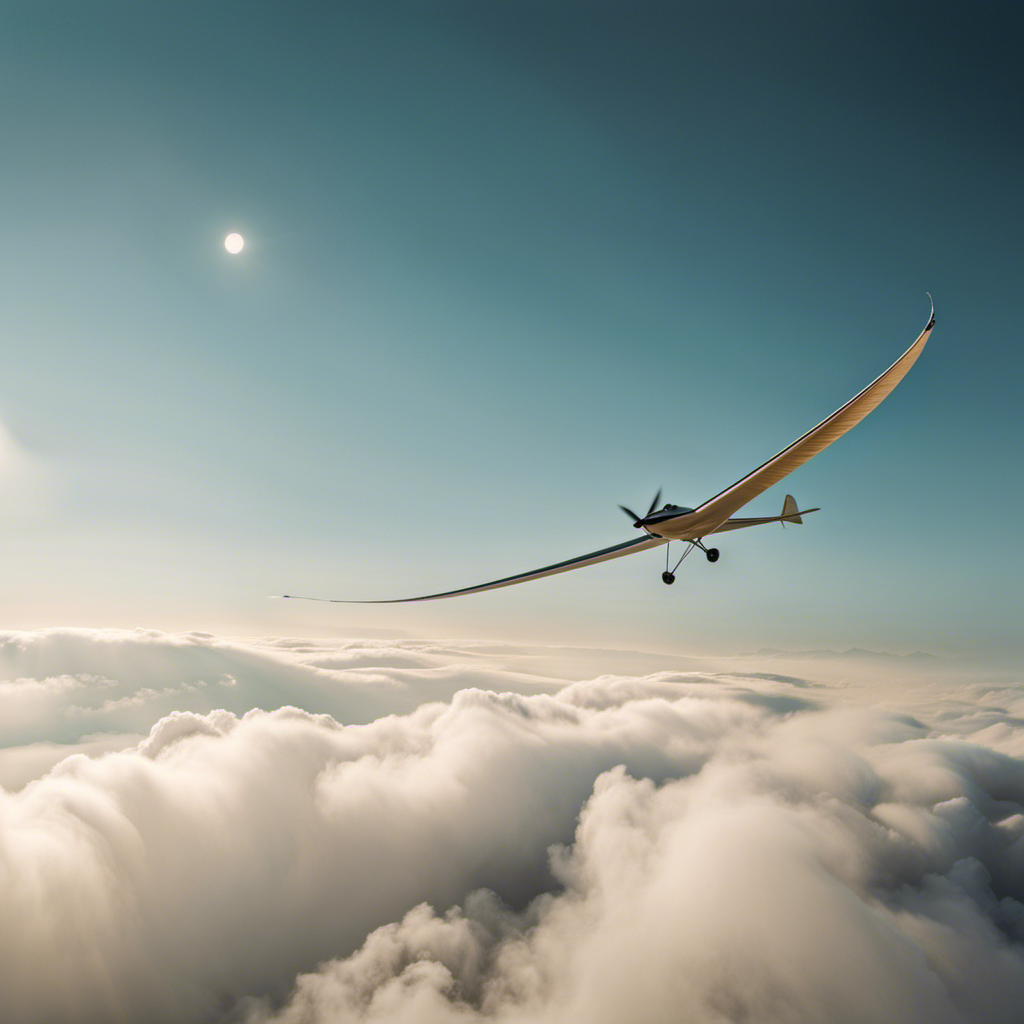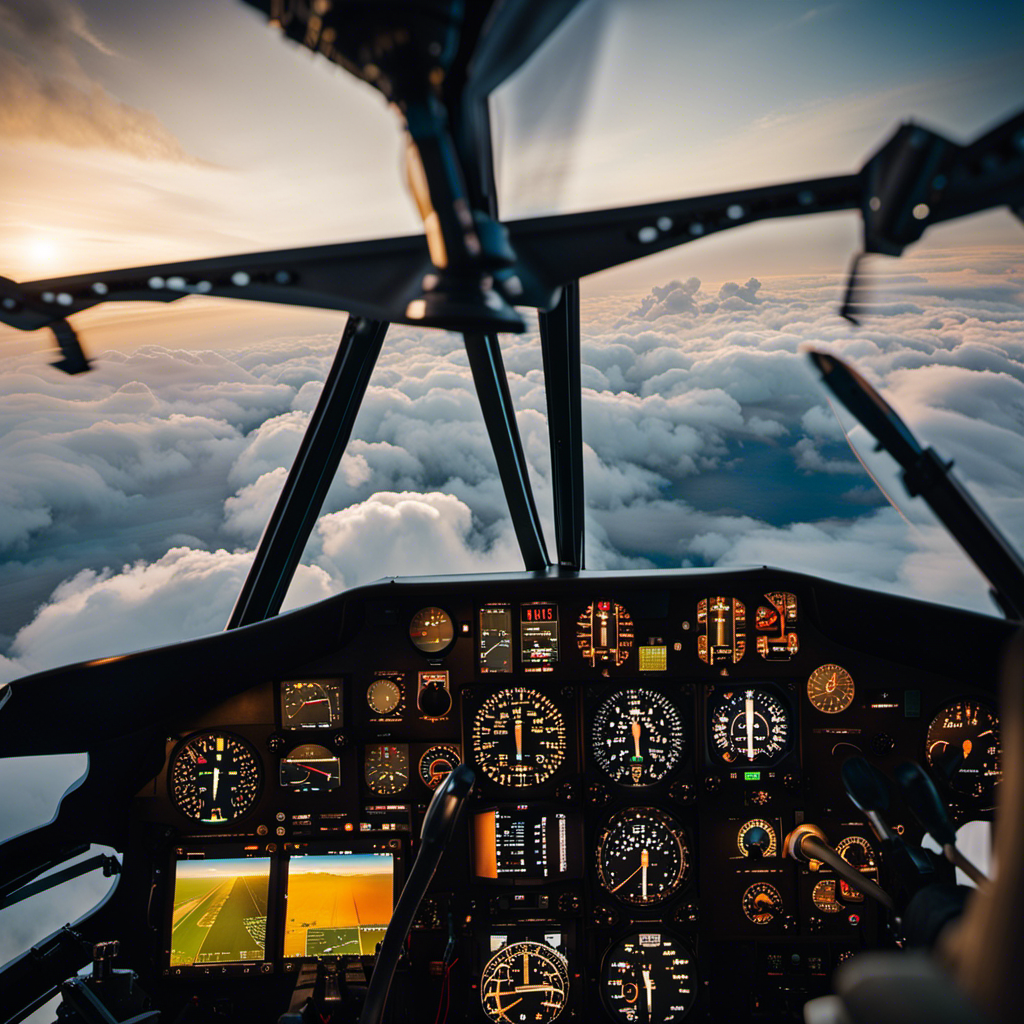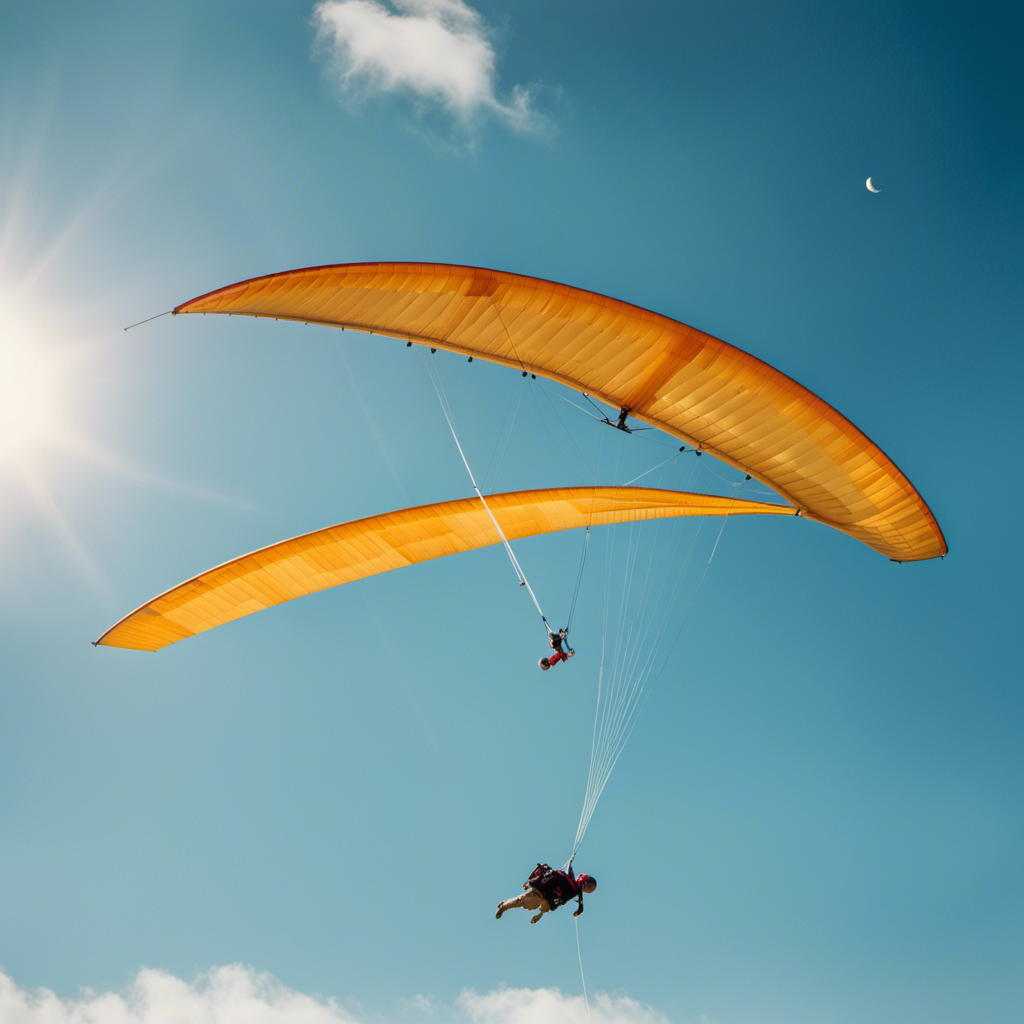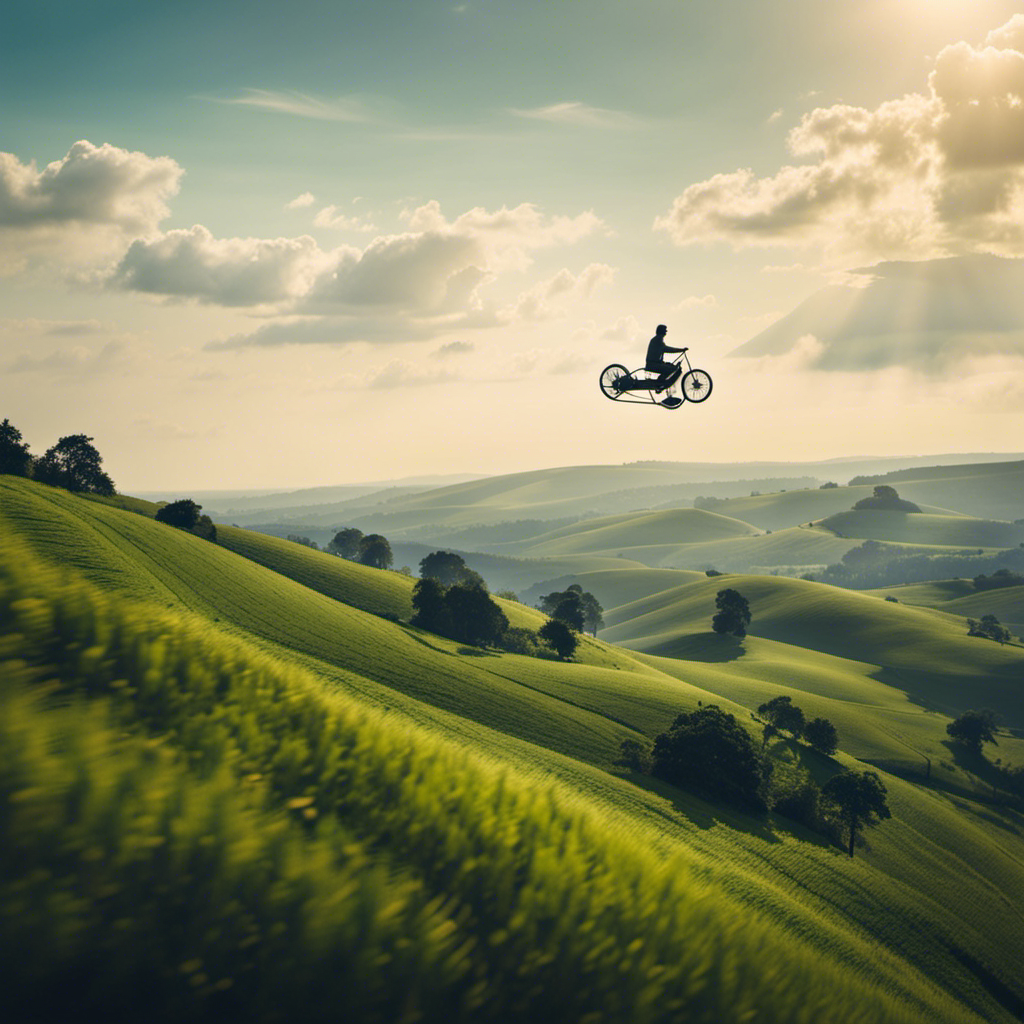As a glider pilot, I am constantly impressed by the impressive endurance of these graceful aircraft. Are you interested in how long gliders can stay in the air?
In this article, we will delve into the fascinating world of glider flight and explore the factors that contribute to their remarkable flight duration. From the basics of glider design to the role of gravity and air currents, we’ll uncover the secrets behind the longest recorded glider flights in history.
So buckle up and prepare to soar through the skies with me as we uncover the science behind glider endurance.
Key Takeaways
- Gliders can maximize flight time by utilizing lifting mechanisms such as thermals and ridge lift.
- Glider racing requires skillful piloting and strategic decision-making, with safety regulations in place.
- Advancements in glider technology focus on energy efficiency, with sleeker designs and integration of solar-powered technology.
- Gliders with solar panels can fly for hours without relying on traditional fuel sources, revolutionizing flight duration.
The Basics of Glider Flight
Gliders can’t stay in the air indefinitely like powered aircraft can. This is because gliders rely on external sources of lift, such as thermals and ridge lift, to sustain their flight.
Glider aerodynamics play a crucial role in utilizing these natural phenomena effectively. Thermals are columns of rising warm air that glider pilots can use to gain altitude. By circling within a thermal, gliders can climb thousands of feet.
Ridge lift, on the other hand, occurs when wind encounters a mountain or hill and is forced to rise. Gliders can use this upward airflow along the slope to extend their flight.
Understanding these principles of glider flight, including glider design and construction, is essential for maximizing the duration and efficiency of each flight.
Understanding Glider Design and Construction
To understand how they’re built and work, you’ll need to dive into the design and construction of these amazing aircraft.
Gliders are meticulously crafted using a combination of lightweight and strong materials. The most common materials used in glider construction are fiberglass, carbon fiber, and aluminum alloy. These materials are chosen for their durability and ability to withstand the forces experienced during flight.
In terms of design, gliders are shaped to minimize drag and maximize lift. They are built with sleek and streamlined fuselages, wings with high aspect ratios, and carefully designed wingtip devices. These design elements, combined with the principles of aerodynamics, allow gliders to achieve great efficiency and soar through the air with minimal power.
Now, let’s explore the role of gravity and air currents in glider flight.
The Role of Gravity and Air Currents in Glider Flight
When you’re soaring in a glider, gravity pulls you down while air currents provide the lift needed to keep you in the sky. Gravity is the force that pulls all objects towards the center of the Earth. In glider flight, it acts against the lift generated by the air currents.
Lift is created when the air flows over the wings, creating a difference in pressure between the upper and lower surfaces. This upward force counteracts gravity and allows the glider to stay aloft.
The impact of wind patterns on glider flight cannot be understated. Wind direction and strength play a crucial role in determining the glider’s speed, endurance, and ability to gain altitude. By strategically using wind patterns, glider pilots can extend their flight times and cover longer distances.
Now, let’s explore the longest recorded glider flights in history.
Longest Recorded Glider Flights in History
You’ll be amazed by the remarkable distances that have been achieved in some of the longest recorded glider flights in history. These record-breaking glider flights have pushed the limits of endurance and showcased the incredible capabilities of these aircraft. Glider flight duration records have been set and broken over the years, with pilots demonstrating their skill and ingenuity in staying aloft for extended periods of time. Here are some examples of the longest recorded glider flights:
| Flight | Duration |
|---|---|
| Flight A | 56 hours |
| Flight B | 72 hours |
| Flight C | 98 hours |
| Flight D | 116 hours |
These flights not only demonstrate the incredible endurance of gliders, but also the skill of the pilots in finding and utilizing thermals and other air currents to maintain lift. However, there are several factors that affect glider endurance, which we will explore in the next section.
Factors that Affect Glider Endurance
One of the factors that can affect glider endurance is the availability of thermals and other air currents. These natural phenomena provide the necessary lift for gliders to stay airborne for extended periods.
However, the materials used in constructing the glider and its weight also play a crucial role in determining its endurance. Glider materials, such as carbon fiber composites, are lightweight yet strong, reducing the overall weight of the glider and allowing for more efficient flight. By minimizing weight, gliders can take advantage of even the slightest air currents and thermals, maximizing their endurance.
Furthermore, the design and construction of the glider must be optimized to minimize drag and increase efficiency. Techniques for extending glider flight time involve utilizing these factors to their full potential, allowing for longer and more exhilarating flights.
Techniques for Extending Glider Flight Time
To extend your glider’s flight time, consider optimizing its design and construction to minimize drag and increase efficiency. Here are three techniques that can help you achieve this:
-
Streamline the shape: A streamlined design reduces the drag caused by air resistance. To achieve this, use smooth and rounded surfaces, eliminate unnecessary protrusions, and ensure proper alignment of all components.
-
Reduce weight: The lighter your glider, the less energy it requires to stay airborne. Use lightweight materials and avoid excessive additions or modifications that add unnecessary weight.
-
Improve wing efficiency: Wings play a crucial role in glider flight. To increase efficiency, ensure proper wing shape and wingtip design, as well as optimal wing loading and aspect ratio.
The Importance of Weather Conditions for Glider Flight
In order to extend the flight time of a glider, it is crucial to consider the weather conditions. Weather forecasting plays a key role in determining the availability of thermals and updrafts, which are essential for glider flight.
Thermals are columns of warm air that rise from the ground, providing lift for gliders to gain altitude. Updrafts, on the other hand, are rising currents of air caused by various weather phenomena. By analyzing weather patterns and using meteorological data, glider pilots can predict the presence and strength of thermals and updrafts, allowing them to plan their flights accordingly.
This knowledge helps pilots navigate through areas with favorable conditions, maximizing their flight duration. Now, let’s delve into the glider piloting skills and strategies for maximizing flight duration.
Glider Piloting Skills and Strategies for Maximizing Flight Duration
By utilizing proper techniques and staying mindful of wind patterns, you can significantly extend your glider flight duration. Glider soaring techniques such as exploiting thermals and ridge lift are essential for maximizing flight time.
Thermals are rising columns of warm air that can provide significant lift to a glider. By circling within a thermal, a pilot can gain altitude and prolong their flight. Ridge lift, on the other hand, occurs when wind encounters a slope and is forced to rise. By flying close to a ridge, pilots can take advantage of this upward lift.
Skillful piloting and strategic decision-making are crucial in order to find and utilize these lifting mechanisms effectively. By mastering these glider soaring techniques, pilots can extend their flight duration and explore the skies with grace and precision.
Transitioning into the next section, glider racing and competitions offer opportunities for pilots to showcase their skills and compete against one another.
Glider Racing and Competitions
Competing in glider races allows pilots to showcase their skills and test their abilities against other pilots. To ensure safety during these competitions, glider safety regulations are strictly enforced. These regulations cover various aspects, such as pilot qualifications and training, equipment maintenance, and flight procedures.
Additionally, understanding glider aerodynamics is crucial for pilots to make strategic decisions during races. Factors such as air density, wind speed, and the glider’s design all play a role in determining its performance and maneuverability. By mastering these principles, pilots can optimize their glider’s efficiency and gain an edge over their competitors.
Transitioning into the next section, advancements in glider technology have revolutionized flight duration, allowing pilots to explore innovations that extend their time in the air.
Innovations in Glider Technology for Extended Flight Duration
Advancements in glider technology have revolutionized flight duration, enabling pilots to explore new innovations that extend their time in the air.
Glider energy efficiency has been a major focus, with designers working tirelessly to reduce drag and optimize lift. These efforts have resulted in sleeker, more aerodynamic designs that maximize glide ratios.
Additionally, the integration of solar powered glider technology has been a game changer. Solar panels mounted on the wings and fuselage harness the sun’s energy, providing a continuous power source that can sustain flight for extended periods. This breakthrough allows pilots to fly for hours on end without relying on traditional fuel sources.
With these advancements, gliders are pushing the boundaries of endurance and opening up new possibilities for exploration and adventure in the skies.
Frequently Asked Questions
What is the maximum altitude a glider can reach during a flight?
During a flight, a glider can reach a maximum altitude determined by factors such as glider performance and atmospheric conditions. The precise altitude can vary, but it is typically achieved through skilled piloting and understanding of aerodynamics.
How long does it take to learn how to fly a glider?
The learning curve for flying a glider varies, but typically it takes several months of training to become proficient. The training duration includes ground instruction, simulator time, and solo flights to develop skills and knowledge needed for safe glider operations.
Can gliders fly at night?
Night flying in gliders requires advanced training and specialized equipment to ensure safety. Glider pilots must rely on instruments and visual cues to navigate in darkness. It’s an exhilarating experience that demands heightened focus and skill.
Are there any age restrictions for glider pilots?
There are no age restrictions for glider pilots, but certain qualifications must be met. These qualifications include passing a medical exam, completing training, and demonstrating the necessary skills and knowledge to safely operate a glider.
How do gliders land without an engine?
Glider landing techniques rely on the aerodynamics of glider landings. By utilizing techniques such as flaring, side slipping, and using spoilers, gliders can safely land without an engine.
Conclusion
In conclusion, the world of glider flight is filled with endless possibilities and challenges. By understanding the basics of glider design and construction, as well as the role of gravity and air currents, pilots can achieve remarkable flight durations.
Factors such as weather conditions and pilot skills also play a crucial role in maximizing flight duration. With advancements in glider technology, the potential for extended flight durations continues to expand.
So, strap in, hone your piloting skills, and soar into the skies with confidence, for the sky is truly the limit for glider flight.
Orion, better known as “Jetstream,” is the voice that brings the stories of the skies to life. His fascination with aviation began at a young age, sparked by his father’s tales of flying and adventure. Orion’s journey into the world of gliding was serendipitous, and from the moment he took his first glider flight, he knew he had found his calling.
